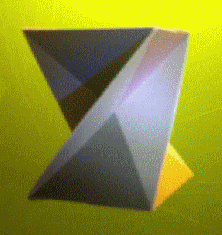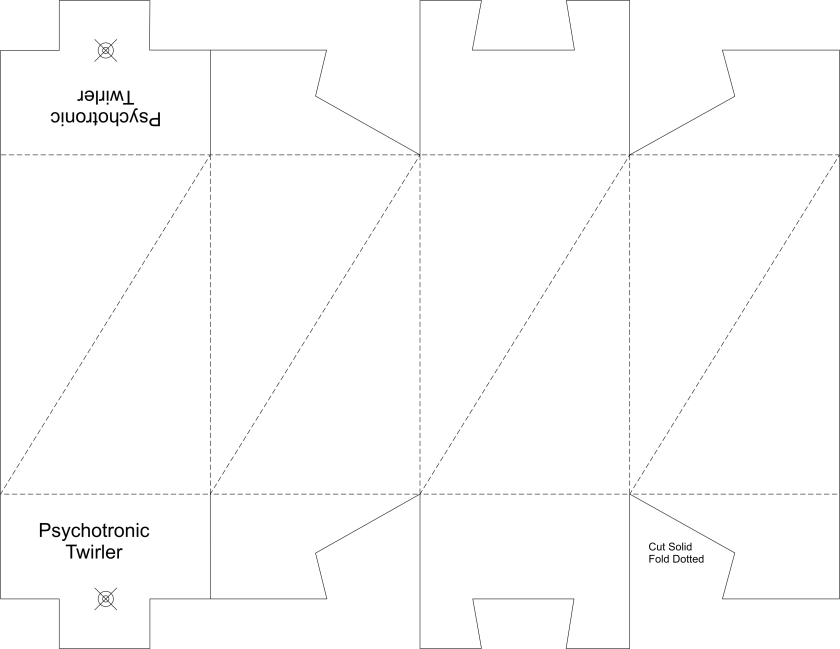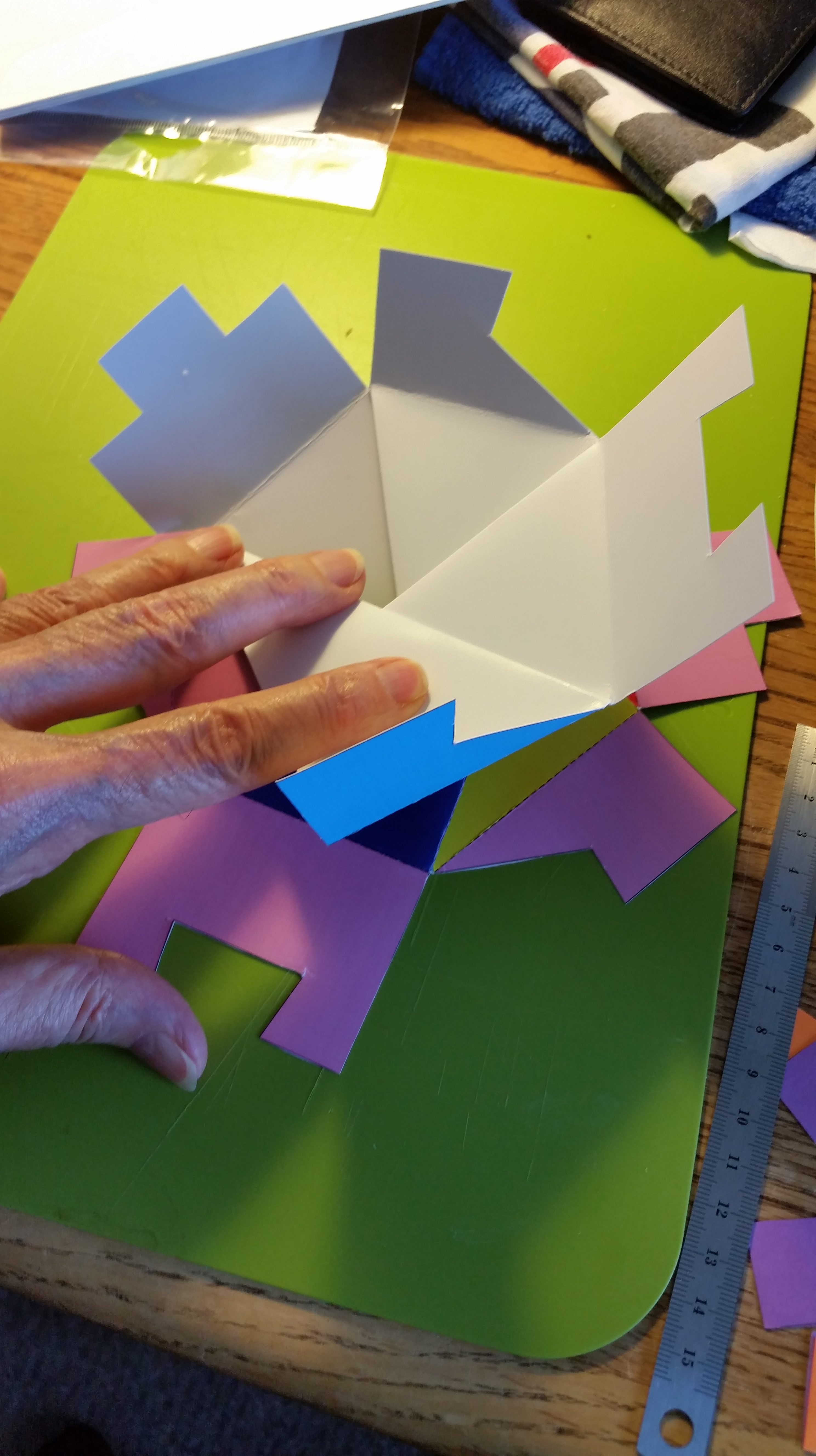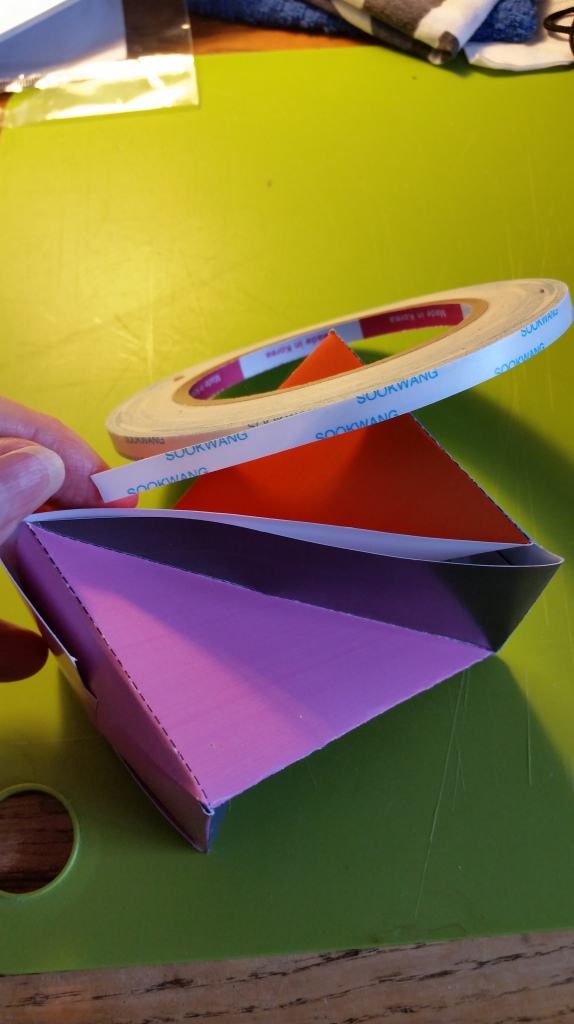Pyramid whizbang Patrick Flanagan published the twirler design. You fold a single sheet of card stock paper into the double-inverted diametric-apex King Cheops psychotronic pyramid shape, then hang it from a string, blow on it, and it twirls. Get the latest design HERE.
 Why psychotronic? Well, Flanagan had a flair for marketing, and the term invokes images of a geometric shape with an extra dose of , psychic, spiritual, spacey, mind-expanding (if not mind-blowing) PYRAMID POWER. You see, the template design allows you to fold the paper into pyramids of the same proportions as the great King Cheops Pyramid, the shape known as a cosmic energy lens or focalizer that preserves organic matter, sharpens razor blades, and does God-only-knows-what to your psyche and meditative and healing and sexual powers, just sitting within a few feet of it or having it hang above your head. It might even make plants grow better.
Regarding Pyramid Power, the proportions of the Great Pyramid of Giza and the Psychotronic Twirler derive from the “golden number” of Phi, the Greek letter φ (Alt-237 on the PC keyboard), the ONLY number whose square equals itself plus one, the ratio of the hypotenuse to the base of a right triangle.
Why psychotronic? Well, Flanagan had a flair for marketing, and the term invokes images of a geometric shape with an extra dose of , psychic, spiritual, spacey, mind-expanding (if not mind-blowing) PYRAMID POWER. You see, the template design allows you to fold the paper into pyramids of the same proportions as the great King Cheops Pyramid, the shape known as a cosmic energy lens or focalizer that preserves organic matter, sharpens razor blades, and does God-only-knows-what to your psyche and meditative and healing and sexual powers, just sitting within a few feet of it or having it hang above your head. It might even make plants grow better.
Regarding Pyramid Power, the proportions of the Great Pyramid of Giza and the Psychotronic Twirler derive from the “golden number” of Phi, the Greek letter φ (Alt-237 on the PC keyboard), the ONLY number whose square equals itself plus one, the ratio of the hypotenuse to the base of a right triangle.
 In other words, φ2=φ+1. And in the golden ratio right triangle with base length of 1, the hypotenuse has length φ=(1+√5)/2, and height has length √φ. We derive that from Pythagoras’ quadratic formula where the square of the hypotenuse equals the sum of the squares of the other two sides. So, the golden ratio is the ratio of φ, or approximately 1.618, to 1. Thus, each half of the Great Pyramid golden triangle has the proportions shown with base=1, slant=φ≈1.618, and height=√φ≈1.272.
We can only presume that the architect of the Great Pyramid of Giza intended to employ the golden ratio because the ratio of its slant edge to half its base varies only .025% from φ.
The term psychotronic concerns”the energy exchange capacities of a mind-body-environment relationship; in other words explaining by technology something that, until recently, was the preserve of Eastern philosophers – how the mind relates to the body in sickness and health” (Woods, David (1976). “Psychotronics: the new science once the preserve of ancient Eastern philosophy”. Can Med Assoc J. 114 (9): 844–847. PMC 1957128. PMID 773526). Perhaps the twirler has psychotronic properties. You must experiment with the twirler to find out for yourself.
In other words, φ2=φ+1. And in the golden ratio right triangle with base length of 1, the hypotenuse has length φ=(1+√5)/2, and height has length √φ. We derive that from Pythagoras’ quadratic formula where the square of the hypotenuse equals the sum of the squares of the other two sides. So, the golden ratio is the ratio of φ, or approximately 1.618, to 1. Thus, each half of the Great Pyramid golden triangle has the proportions shown with base=1, slant=φ≈1.618, and height=√φ≈1.272.
We can only presume that the architect of the Great Pyramid of Giza intended to employ the golden ratio because the ratio of its slant edge to half its base varies only .025% from φ.
The term psychotronic concerns”the energy exchange capacities of a mind-body-environment relationship; in other words explaining by technology something that, until recently, was the preserve of Eastern philosophers – how the mind relates to the body in sickness and health” (Woods, David (1976). “Psychotronics: the new science once the preserve of ancient Eastern philosophy”. Can Med Assoc J. 114 (9): 844–847. PMC 1957128. PMID 773526). Perhaps the twirler has psychotronic properties. You must experiment with the twirler to find out for yourself.
 I liked the twirler idea, so I adapted the Flanagan design in Corel Draw, colored it, printed it out, cut and folded it, attached a string to it, and hung it from a lamp beside my desk. Maybe its energy will have a good effect in my digs. I attached two fridge magnets to one of the hanging twirlers, and it automatically swiveled around to align the edge to true north, even though the air conditioning breeze makes it swivel back and forth from that alignment, creating a sinusoidal energy blast in my direction, I imagine. Just look at this baby TWIRL! You can almost SEE the power curves of the energy radiating from its diametric apex!
You must make the creases in your folds nice and tight, and perfectly aligned. I use my Martha Stewart Bone Folder to score the dotted lines and press hard up and down the creases. That helps the shape come together perfectly.
It looks like the image below before you cut and fold it. I designed this to take a full sheet of paper, so that the end panels and right end tab extend all the way to the edges of the paper. You can elect to leave the end panels square so that you can fold them to overlap, or to cut them as shown so that you can fold them to interlock.
I liked the twirler idea, so I adapted the Flanagan design in Corel Draw, colored it, printed it out, cut and folded it, attached a string to it, and hung it from a lamp beside my desk. Maybe its energy will have a good effect in my digs. I attached two fridge magnets to one of the hanging twirlers, and it automatically swiveled around to align the edge to true north, even though the air conditioning breeze makes it swivel back and forth from that alignment, creating a sinusoidal energy blast in my direction, I imagine. Just look at this baby TWIRL! You can almost SEE the power curves of the energy radiating from its diametric apex!
You must make the creases in your folds nice and tight, and perfectly aligned. I use my Martha Stewart Bone Folder to score the dotted lines and press hard up and down the creases. That helps the shape come together perfectly.
It looks like the image below before you cut and fold it. I designed this to take a full sheet of paper, so that the end panels and right end tab extend all the way to the edges of the paper. You can elect to leave the end panels square so that you can fold them to overlap, or to cut them as shown so that you can fold them to interlock.
 You can print the following image to take up a full sheet of 8.5″ x 11″ card stock. You will glue or double-sticky-tape the backs of the red and brown triangular panels together.
I changed the colors somewhat to show the pyramid shapes. Also, you print this one in portrait rather than landscape mode
You can print the following image to take up a full sheet of 8.5″ x 11″ card stock. You will glue or double-sticky-tape the backs of the red and brown triangular panels together.
I changed the colors somewhat to show the pyramid shapes. Also, you print this one in portrait rather than landscape mode

You can print the following PDF file. The edges of the image leave a .2″ margin so that any home printer should print the full image:
Print this one if you want to draw your own image onto the template before you cut and fold it. You can also load it into the vector drawing program Inkscape, trace it to create a vector drawing, and then fill the panels with whatever colors or patters or drawings you like.
 I put the X on the end panels to make it easy to poke a hole there with a straight pin or needle so as hang the twirler from a thread. I have thought that a proper “twirler” should have a swivel that insulates it from the force of the twists in the thread, but I have not devised that yet.
This will make a fun gift box for candies or small jewelry. I have designed two layers in the art file for the end panels: square and interlocking. If they interlock, you won’t have to glue or tape them, and that makes them perfect for turning the twirler into a packaging box for small things. Interlocked, the ends look like this:
I put the X on the end panels to make it easy to poke a hole there with a straight pin or needle so as hang the twirler from a thread. I have thought that a proper “twirler” should have a swivel that insulates it from the force of the twists in the thread, but I have not devised that yet.
This will make a fun gift box for candies or small jewelry. I have designed two layers in the art file for the end panels: square and interlocking. If they interlock, you won’t have to glue or tape them, and that makes them perfect for turning the twirler into a packaging box for small things. Interlocked, the ends look like this:
 When you have folded it into the basic shape above, and then look into it through the open bottom and top, you see perfectly dimensioned opposing pyramids sharing a common apex point. I absolutely love the symmetry of it, and could not resist coloring it.
Speaking of colors, I chose those because my Urantia Book ‘s papers on racial groups indicates the original people resembled Eskimos. Then one family half a million years ago procreated children whose skin colors became vivid in the sunlight – red, yellow, blue, orange, green, indigo. Then it says Adam and Eve became progenitors of the violet race whose bodies glowed with a violet hue. All of that inspired the eight colors for the triangular panels.
See the link for the latest design at the top of this article.I produced the template in Corel Draw, Adobe Illustrator, and other formats, in case you want to diddle with it. You might change the colors, or adorn the panels with dazzling psychedelic eye-candy fractals or cattails.
See how to fold it to make the twirler shape here and use the photos below as a guide.
If you find it challenging to fold, start with the tabbed panel, fold the colored triangles along the diagonal lines so the triangles face one another, and fold the rectangular edges along the perpendicular lines so their backs face one another. Proceed from panel to panel, folding accordian style until you have a star shape.
When you have folded it into the basic shape above, and then look into it through the open bottom and top, you see perfectly dimensioned opposing pyramids sharing a common apex point. I absolutely love the symmetry of it, and could not resist coloring it.
Speaking of colors, I chose those because my Urantia Book ‘s papers on racial groups indicates the original people resembled Eskimos. Then one family half a million years ago procreated children whose skin colors became vivid in the sunlight – red, yellow, blue, orange, green, indigo. Then it says Adam and Eve became progenitors of the violet race whose bodies glowed with a violet hue. All of that inspired the eight colors for the triangular panels.
See the link for the latest design at the top of this article.I produced the template in Corel Draw, Adobe Illustrator, and other formats, in case you want to diddle with it. You might change the colors, or adorn the panels with dazzling psychedelic eye-candy fractals or cattails.
See how to fold it to make the twirler shape here and use the photos below as a guide.
If you find it challenging to fold, start with the tabbed panel, fold the colored triangles along the diagonal lines so the triangles face one another, and fold the rectangular edges along the perpendicular lines so their backs face one another. Proceed from panel to panel, folding accordian style until you have a star shape.

 Take the four adjacent end panels and bring them together as you fold them inward. That will form the proper twirler shape.
Take the four adjacent end panels and bring them together as you fold them inward. That will form the proper twirler shape.
 Then close up the end panels.
Then close up the end panels.
 Glue or double-sticky-tape the inside surfaces of opposing edges together, taking care to keep them in perfect alignment.
Glue or double-sticky-tape the inside surfaces of opposing edges together, taking care to keep them in perfect alignment.
 After the glue dries, loosen the end enclosures. Use a needle and thread to poke a hole at the center of the X in the end panel. Run the needle through the apex into the opposing pyramid. Tie the end of the thread to a small piece of paper so the end won’t pull through the apex. Close up the end panels and pull the thread taut through the pin hole in the end panel. Hang the twirler by that thread to a light fixture or door frame, or thumbtack it to the ceiling near air flow. Watch it twirl.
After the glue dries, loosen the end enclosures. Use a needle and thread to poke a hole at the center of the X in the end panel. Run the needle through the apex into the opposing pyramid. Tie the end of the thread to a small piece of paper so the end won’t pull through the apex. Close up the end panels and pull the thread taut through the pin hole in the end panel. Hang the twirler by that thread to a light fixture or door frame, or thumbtack it to the ceiling near air flow. Watch it twirl.
 Have fun.
Have fun.
 Why psychotronic? Well, Flanagan had a flair for marketing, and the term invokes images of a geometric shape with an extra dose of , psychic, spiritual, spacey, mind-expanding (if not mind-blowing) PYRAMID POWER. You see, the template design allows you to fold the paper into pyramids of the same proportions as the great King Cheops Pyramid, the shape known as a cosmic energy lens or focalizer that preserves organic matter, sharpens razor blades, and does God-only-knows-what to your psyche and meditative and healing and sexual powers, just sitting within a few feet of it or having it hang above your head. It might even make plants grow better.
Why psychotronic? Well, Flanagan had a flair for marketing, and the term invokes images of a geometric shape with an extra dose of , psychic, spiritual, spacey, mind-expanding (if not mind-blowing) PYRAMID POWER. You see, the template design allows you to fold the paper into pyramids of the same proportions as the great King Cheops Pyramid, the shape known as a cosmic energy lens or focalizer that preserves organic matter, sharpens razor blades, and does God-only-knows-what to your psyche and meditative and healing and sexual powers, just sitting within a few feet of it or having it hang above your head. It might even make plants grow better. In other words, φ2=φ+1. And in the golden ratio right triangle with base length of 1, the hypotenuse has length φ=(1+√5)/2, and height has length √φ. We derive that from Pythagoras’ quadratic formula where the square of the hypotenuse equals the sum of the squares of the other two sides. So, the golden ratio is the ratio of φ, or approximately 1.618, to 1. Thus, each half of the Great Pyramid golden triangle has the proportions shown with base=1, slant=φ≈1.618, and height=√φ≈1.272.
In other words, φ2=φ+1. And in the golden ratio right triangle with base length of 1, the hypotenuse has length φ=(1+√5)/2, and height has length √φ. We derive that from Pythagoras’ quadratic formula where the square of the hypotenuse equals the sum of the squares of the other two sides. So, the golden ratio is the ratio of φ, or approximately 1.618, to 1. Thus, each half of the Great Pyramid golden triangle has the proportions shown with base=1, slant=φ≈1.618, and height=√φ≈1.272. I liked the twirler idea, so I adapted the Flanagan design in Corel Draw, colored it, printed it out, cut and folded it, attached a string to it, and hung it from a lamp beside my desk. Maybe its energy will have a good effect in my digs. I attached two fridge magnets to one of the hanging twirlers, and it automatically swiveled around to align the edge to true north, even though the air conditioning breeze makes it swivel back and forth from that alignment, creating a sinusoidal energy blast in my direction, I imagine. Just look at this baby TWIRL! You can almost SEE the power curves of the energy radiating from its diametric apex!
I liked the twirler idea, so I adapted the Flanagan design in Corel Draw, colored it, printed it out, cut and folded it, attached a string to it, and hung it from a lamp beside my desk. Maybe its energy will have a good effect in my digs. I attached two fridge magnets to one of the hanging twirlers, and it automatically swiveled around to align the edge to true north, even though the air conditioning breeze makes it swivel back and forth from that alignment, creating a sinusoidal energy blast in my direction, I imagine. Just look at this baby TWIRL! You can almost SEE the power curves of the energy radiating from its diametric apex!









1 comment:
WOW! that is amazing! I want one!!!
Post a Comment